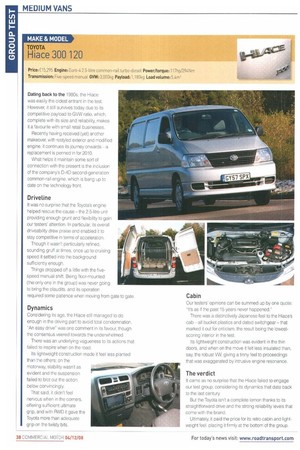Hiace 300 120
Page 38

If you've noticed an error in this article please click here to report it so we can fix it.
Price: £15295 Engine: Euro-4 2.5-litre common-rail turbo-diesel Power/torque: 117hp/294N m Transmission: Five-speed manual GVW:3.000kg Payload: 1,180kg Load volume: 54m Dating back to the 1980s, the Hiace was easily the oldest entrant in the test. However, it still survives today due to its competitive payload to GVW ratio, which, complete with its size and reliability, makes it a favourite with small retail businesses.
Recently having received (yet) another makeover, with restyled exterior and modified engine, it continues its journey onwards a replacement is penned in for 2010.
What helps it maintain some sort of connection with the present is the inclusion of the company's D-4D second-generation common-rail engine, which is bang up to date on the technology front.
Driveline
It was no surprise that the Toyota's engine helped rescue the cause the 2.5-litre unit providing enough grunt and flexibility to gain our testers' attention. In particular, its overall driveability drew praise and enabled it to stay competitive in terms of acceleration.
Though it wasn't particularly refined, sounding gruff at times, once up to cruising speed it settled into the background sufficiently enough.
Things dropped off a little with the fivespeed manual shift. Being floor-mounted (the only one in the group) was never going to bring the plaudits. and its operation required some patience when moving from gate to gate.
Dynamics
Considering its age, the Hiace still managed to do enough in the driving part to avoid total condemnation. An easy drive" was one comment in its favour, though the consensus veered towards the underwhelmed.
There was an underlying vagueness to its actions that failed to inspire when on the road.
Its lightweight construction made it feel less planted than the others; on the motorway, stability wasn't as evident and the suspension failed to blot out the action below convincingly.
That said, it didn't feel nervous when in the corners, offering sufficient ultimate grip, and with RWD it gave the Toyota more than adequate grip on the twisty bits.
Cabin
Our testers opinions can be summed up by one quote: "It's as if the past 15 years never happened."
There was a distinctively Japanese feel to the Hiace's cab all bucket plastics and dated switch gear that marked it out for criticism, the result being the lowestscoring interior in the test.
Its lightweight construction was evident in the thin doors, and when on the move it felt less insulated than, say, the robust VW, giving a tinny feel to proceedings that was exaggerated by intrusive engine resonance.
The verdict
It came as no surprise that the Hiace failed to engage our test group, considering its dynamics that date back to the last century.
But the Toyota isn't a complete lemon thanks to its straightforward drive and the strong reliability levels that come with the brand.
Ultimately, it paid the price for its retro cabin and lightweight feel, placing it firmly at the bottom of the group.




















































































































































